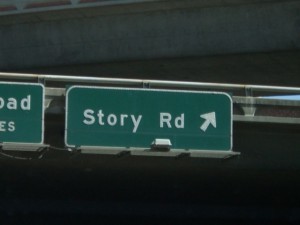Marc A. Pitman's Blog, page 32
July 1, 2015
Thank you for connecting donors with mission
For many FundraisingCoach.com readers, today - July 1st - is the start of a brand new fiscal year. The amount raised starts at zero but the goals are set higher.
As fundraisers, we rarely get thanked, and that's fine. The nature of our work puts the emphasis on the donors and the impact they create through our nonprofits. But today I wanted to pause and say: Thank you.
To all who raise money, thank you.
Because of your work, donors are finding the way to invest in their values.
Because of your work, people are being fed. Kids are being educated. Land is being conserved. Animals are being cared for.
Because of your work, the nonprofit sector is the providing meaningful work for tens of millions of people and their families. (Over 10.7 million people are employed by nonprofits in the United States alone, making it third largest workforce here.)
Thanks for making the world a better place. I firmly believe generosity is hardwired in human beings. It's one of the best parts of us. As a fundraiser, your leadership is helping people express the best in themselves. Thank you.
Here's a video I recorded a few years ago, as a thank you for fundraisers. It applies just as much on July 1 as it does on June 30.
Is today your fiscal new year? Or is it another time of the year? Let us know at: http://FundraisingCoach.com/fiscalyear/
The post Thank you for connecting donors with mission appeared first on FundraisingCoach.com.






June 29, 2015
Donor Fatigue – the rest of the story
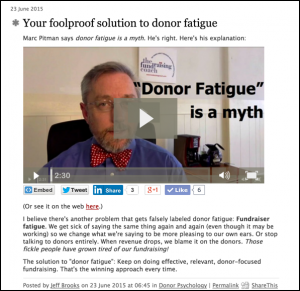 In his recent post, Jeff Brooks agreed with my “Donor Fatigue” video. And he went a step further. Like a newly minted Paul Harvey, he tells “the rest of the story.”
In his recent post, Jeff Brooks agreed with my “Donor Fatigue” video. And he went a step further. Like a newly minted Paul Harvey, he tells “the rest of the story.”
Fundraiser Fatigue
I love his concept of “fundraiser fatigue”! He says that we get tired of saying the same thing over and over so we just stop. And then blame the lack of donations on "donor fatigue."
Be honest: do you get sick and tired of saying the same thing over, and over, and over? Do you ever worry that you’re telling someone a story that they’ve already heard? It's o.k. All great fundraisers have.
I have two responses to this natural situation:
Enjoy feeling repetitive
Donor’s universes do not revolve around your nonprofit. So even if you’ve said something over and over, you’re still may not be breaking through. The ad guru David Ogilvy is supposed to have said that it takes a person hearing the same message 7 times before they take action.
So make sure to tell the stories seven times. Or even 17. I once wrote a post called "Tired of Your Nonprofit's Story? Good!". In it I say, "Fundraising happens after you get bored." (Click here to tweet that.)
Effective fundraising happens AFTER you get bored with your nonprofit story!
http://t.co/uWDTI4QGAr
— Marc A. Pitman (@marcapitman) June 26, 2015
Tell stories that connect with donors
Another reason we get bored with our stories is that we fear they’re not connecting with donors. And with the average nonprofit only retaining 30% - 40% of its donors, we’re right. Our stories aren’t connecting. How do we fix that?
Start talking with donors, not at them! Here are some questions to consider:
What got you started giving to us?
When did we first get on your radar screen?
When you think of your support over the years, what impact are you most proud of helping create?
What do you think [insert your nonprofit’s name here] does best?
Ask these questions out of sincere gratitude. You’re intent is not to interrogate your donors!
Start talking with your donors, not at them!
http://t.co/uWDTI4QGAr
— Marc A. Pitman (@marcapitman) June 26, 2015
Fundraising isn’t about YOUR enjoyment
Fundraising is a tremendously rewarding career. But it’s never supposed to be about your enjoyment. Fundraising is about raising money by connecting donors with your nonprofit’s impact. Get used to feeling you’re saying the same thing over, and over. And rest in the fact that only people you see daily will know how repetitive you’re being.
You'll find you reconnect with your passion ask you ask donors about their passion.
Do these, and you’ll thwart both donor fatigue and fundraiser fatigue! And you’ll be able to get on with your effective fundraising!
The post Donor Fatigue – the rest of the story appeared first on FundraisingCoach.com.






June 16, 2015
Charitable giving grows again!
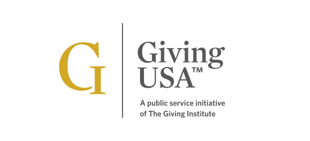 The new GivingUSA report is out. The estimates of last year's giving, the most recent on record, appear to be the best in the 60 years of tracking.
The new GivingUSA report is out. The estimates of last year's giving, the most recent on record, appear to be the best in the 60 years of tracking.
As a sector, we are still impressed by low-growth. But 5% growth is better than no growth!
According to GivingUSA's press release:
Overall charitable giving in the USA last year was $358.38 billion
Individual Giving increased 5.7% in current dollars to $258.51 billion
Bequest Giving increased 15.5% to $28.13 billion
Foundation Giving went up to $53.97 billion, up 8.2% from last year
Corporate Giving did go up as well to $17.77 billion an increase of 13.7% over the previous year
Focus your efforts
For me, the biggest take away from this report is what hasn't changed: individuals still gave the vast majority of all charitable donations!
These statistics are:
Individuals 72%
Bequests 8%
Foundations 15%
Corporations 5%
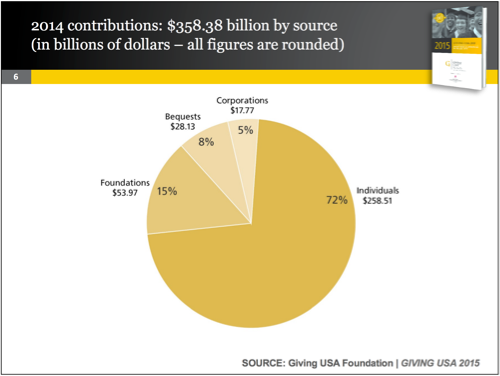
GivingUSA reports charitable giving grows to highest levels last year. Image (c) GivingUSA
This is the sort of information that should be in your nonprofit's board orientation.
In the new online course Fundraising 101, I challenge board members and new fundraisers to organize their time this way. If 80% of giving comes from individuals, why not spend 80% of your effort and resources learning to effectively engage individuals? I actually show years and years of GivingUSA data to back up this claim. (If your board doesn't want you to constantly focus on more grants and corporate gifts, you're fine. And blessed.)
The best part of learning to effectively work with individuals? Who runs foundations and corporations? Individuals, of course! So focusing on individuals will help your nonprofit's fundraising be far more effective!
For more information
You can get the GivingUSA report at: http://givingusa.org/
You can get the Fundraising 101 course at: http://fundraisingcoach.com/university/courses/fundraising-101/
The post Charitable giving grows again! appeared first on FundraisingCoach.com.






June 12, 2015
Are you stuck in “professional” mode?
Today I wore a t-shirt...to make a point! As a nonprofit leader, it's so easy to be "on" all the time. Especially if you live in a small town. I used to spend more time than I'd like to admit wondering if I should get back into "professional" clothes before I went to the store.
But when you're "always on," you're boring. No one like 1-dimensional people. In this video, I tell you how to stop being boring and get more effective at fully funding your nonprofit!
The post Are you stuck in “professional” mode? appeared first on FundraisingCoach.com.






June 4, 2015
The Red Cross and Glass Houses
"Why can’t you tell us where you spent the money and what your expenses were? You obviously have that information. Why can’t the public see it?"
- NPR's Laura Sullivan to Red Cross' David Meltzer
Last night, I was shocked and spellbound to hear NPR devote an entire half hour segment to the special report called: In Search Of The Red Cross' $500 Million In Haiti Relief. NPR and Pro Publica's reporting seems fair, detailed, and well-balanced. Listening to is was like watching a train wreck: fascinating and painful. Years ago, I heard a speaker refer to studies showing that when people see bad things from just two nonprofits - the Red Cross and the United Way - they assume these bad things are true of the entire sector. But our donors don't hear the story as "about them." They hear it as "about nonprofits." And worse, about us.
So this "exposé" affects us all.
It would be really easy for us to shake our heads and point fingers. We could talk about the problems of bureaucracy and management fees, patting ourselves on the back for being more efficient because we're small. We could debate whether the Red Cross experienced mission creep - trying to go beyond their strength of disaster relief and trying to move into the unfamiliar territory of rebuilding.
But ask yourself if your organizaiton would have the guts to do what Doctors Without Borders did: telling people to stop giving to them for Haiti relief since they'd raised enough. That takes both guts, integrity, and a crystal clear understanding of your organizational abilities.
We're living in glass houses
This story needs to be a wake-up call. How would you answer NPR's Laura Sullivan's question to the Red Cross: "Why can’t you tell us where you spent the money and what your expenses were? You obviously have that information. Why can’t the public see it?"
Would you pull out the documentation and show her? Or would you sound like you're trying to hide something like the Red Cross spokesperson did?
In the last couple of weeks, I've spoken with two small nonprofits who are rising to the challenge. They've been subjecting their financials to a rigorous independent audit. Both organizations discovered some issues in their reporting that they needed to clean up. Nothing catastrophic. But it was much better for them to find those themselves than for NPR to find them first. And now, both organizations are much more prepared to answer the "where did the money go" question.
Please resist the urge to throw stones at the Red Cross. Let's be honest, we're all living in glass houses. Even if we're not dealing with hundreds of millions of dollars, very few of our nonprofits would be able to track a donors gift from donation to impact like charity:water does. But if you've been paying attention at all, each new generation of donors increasingly want transparency.
We can get frustrated that donors' expectations are changing and go out of business, eliminating any potential of future good our nonprofit could do. Or we can rise to the challenge and learn to tell the story of our finances.
If you outsourced your projects to other charities, share the compelling reasons.
If you charge management fees, explain why management is crucial for responsibly stewarding your donors gifts.
If you changed your approach, like from building new houses to repairing shacks, be ready to explain why. And to explain it to both your donors and to the residents who were promised the new houses. Especially if you say the project still costs the same $24 million despite the change.
How to prepare your nonprofit today
Block out 30-minutes to listen to NPR's Red Cross story.
Resist the urge to feel smug or to feel relief that NPR didn't call you.
Listen to the questions donors are asking. The voice is Laura Sullivan's but the questions are those your donors are asking.
Then start working now to figure out how you'll answer those questions.
Answering these questions feels like getting naked. Like being exposed. Pay special attention to the places you think, "We can't possibly tell our donors that!" In our increasingly digital world, the things we desperately want to hide are easier than ever for others to find. Once you can you tell your numbers story without cringing, can your board? If we can't stand behind our numbers, we don't have the right to be handling somebody's donations.
The post The Red Cross and Glass Houses appeared first on FundraisingCoach.com.






May 22, 2015
[Guest Post] Crowdfunding – Not the Hail Mary You Think
Today it's my pleasure to introduce you to Dana Ostomel, the founder of Deposit a Gift.com. Deposit a Gift allows anyone - nonprofits, schools, or individuals - to raise money and even sell tickets to benefit events. I love that Dana's background is in marketing. She's developed solutions for brands like Snapple, Century21, The Home Depot, and DirecTV. With Deposit A Gift, she brings this experience to help people and organizations in planning and marketing their crowdfunding goal. Dana recently presented an entire session on how to do crowdfunding for The Nonprofit Academy. So I asked her to share some thoughts here too!
You can learn more about Deposit A Gift at http://www.depositagift.com/ and you can follow her and the team on Twitter @DepositAGift
Crowdfunding - Not the Hail Mary You Think

by Dana Ostomel, founder and Chief Gifting Officer of Deposit a Gift.com
You've probably heard the buzz around "crowdfunding." But what is it, and how does it work?
Crowdfunding is quickly becoming the go-to approach to raise money online for many things, it's a way to raise money by leveraging your social networks, and it's probably been brought up in at least one board meeting as something your organization should try. But is it a good idea? The answer is yes, absolutely! The consumer expectation has fundamentally shifted for how they will be asked to support organizations in need. Interestingly, this shift has been driven by the for-profit and personal fundraising worlds, but it has strongly influenced the giving experience that people now expect to engage in when donating. Gone are the days of sterile transactional donation pages. People want fun, easy, shareable and social.
What does that mean for you? It's time to welcome a more interactive approach to giving called "crowdfunding"!
And though that might be scary to those who are unsure what this implies for their yearly campaigns, personal workload or approach to online community development, the reality is that it is here to stay, and when done right, can add a wonderful dimension to not only how the organization raises money, but how it engages with, and fosters, its community. However with all the hype about campaigns going viral without any effort (totally untrue!) there are a lot of misconceptions about what it actually takes to make a campaign "go." It's about more than just making a page and hoping that the Internet will shower you with money; you've got to have a plan.
Build a crowdfunding strategy and incorporate it in your overall fundraising strategy
Unfortunately, many are making the big mistake of treating their crowdfunding campaign as a one-off, strategic-less, "Hail Mary"'s. Not just because it is a lost opportunity to build relationships with donors, but because if it doesn't do well, it may mistakenly lead you and your board to think that a social approach to fundraising "isn't for us."
What does it mean to make this mis-step? It means merely creating a campaign page and expecting to get a response with little promotion or go-to-market strategy. Riffing off of something that may be more familiar to you, it's no different from doing a capital campaign – you've got to have a plan:
a way of lining-up donors,
a vision to get momentum,
a strategy for the big community reveal.
10 considerations for a successful crowdfunding campaign
For those of you who intend to try a campaign this year, or want a do-over on one that didn't go well in the past, here are 10 considerations to help you plan for a successful campaign:
You need a story that makes people care and share.
The story is not enough. Successful crowdfunding is about marketing.
You must have a network to market to.
You will be connected to the majority of your supporters initially.
To reach beyond your initial network, takes work and a strategy.
Personal relationships will play a key role.
You can't do this alone. You need an online "street team."
The 'soft launch' is critical and will set the tone for the campaign.
Frequent communication is everything: Lots of emails and postings.
Don't expect people to share unprompted.
Let’s face it, we are not going back to the old way of fundraising. Though it may take some experimentation to find out what approach will work for your organization, it is important to start this journey now with an eye towards changing the culture of giving and online engagement within the next 2-5 years. That is a reasonable expectation if approached thoughtfully and methodically, and right NOW.
So, what next? Be honest with yourself: do you have a community that is engaged enough to launch a campaign to? If you do, great, start plotting out how you will motivate people to not only give, but also share with their friends.
If you don't feel your community is ready, pick a target date that you can work towards (maybe #GivingTuesday 2015 – that would give you about 6 months to plan). You'll then want to do 2 things simultaneously:
Start a basic community engagement program: make sure you are sending out at least one e-newsletter a month sharing all the great things you are doing. Make them feel good for being a supporter and get them more engaged without asking for anything.
Start planning the kind of campaign you want to do and back into the timeline and marketing strategy, which will also inform your approach to the community engagement program.
The key is that you can't launch to no network, or a dead network, so do what you think is necessary to create one that is primed (and pumped!) for the upcoming campaign. Remember that people who feel a part of the backstory are more engaged and more likely to offer their support.
So crowdfunding isn't just a "Hail Mary" pass. But one of the neatest things about crowdfunding is that it is something you can integrate into any campaign that you typically do each year. At it's most basic level, "crowdfunding" is simply "online social fundraising." So when you think of it that way, it's really about creating an online social home that you point all campaign communications to. The more people you can get to give through your crowdfunding campaign site, the more chance you have to get them to share – and that, friends, is the key to the power of the crowd!
For more crowdfunding basics, check out Deposit A Gift's blog at: http://www.depositagift.com/_/e/crowdfunding-basics/.
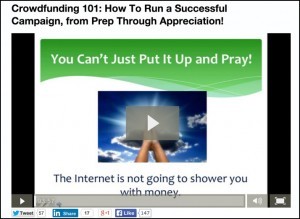 Dana also did an amazing 90-minute "Crowdfunding 101" webinar for The Nonprofit Academy. You can learn more about that by clicking on the image or by going to Crowdfunding 101 (And NPA members are offered a special discount.)
Dana also did an amazing 90-minute "Crowdfunding 101" webinar for The Nonprofit Academy. You can learn more about that by clicking on the image or by going to Crowdfunding 101 (And NPA members are offered a special discount.)
The post [Guest Post] Crowdfunding – Not the Hail Mary You Think appeared first on FundraisingCoach.com.






May 20, 2015
Donor Fatigue is a myth
I firmly believe "donor fatigue" is a cop out, not a reality. In this quick video, I tell you why. And I give you a free tool to fix your next fundraising letter.
For more on this, check out:
The free fundraising letter email course at" http://fundraisingcoach.com/fundraising-letters/
The new Fundraising 101 video class for board members and "accidental" fundraisers at: http://fundraisingcoach.com/university/courses/fundraising-101/
And the official site for The Nonprofit Storytelling Conference at: http://bit.ly/NPStoryConf
The post Donor Fatigue is a myth appeared first on FundraisingCoach.com.






May 7, 2015
Millenials aren’t really that different!
"Selfie" by Patrik Nygren. Used with permission.
https://flic.kr/p/nk9b1w
But their kids, the SILENT GENERATION started questioning the blind dependence on large organizations. Those questions became much louder in the BOOMERS. In fact, Boomers loudly asked questions like, "Your charity is good? So what. What's in it for me?"
Boomers raised, GENERATION X who took the question "are you relevant to me" to a whole new level. We in Gen X are even less trusting of organizations. We're the ones that have been marketed to since birth, often through Saturday morning cartoons and after school specials. And we saw companies fire our parents or our friends' parents, so we know there isn't security in organizations or programs. We wanted to volunteer first to see if we could trust the charity's leaders. And since many of our generation had to take care of themselves from an early age, we're pretty scrappy. We're great at figuring cheaper and more effective ways of doing things and want to see that in our charities. If we don't, we'll just find a way to do it ourselves.
Both Gen Xers and some late Boomers have raised MILLENIALS. Millenials have all the characteristics of their parents but there are so many Millenials charities are no longer able to ignore them. Millenials take our questions and scrappiness to a new level of expecting access to the top leaders and transparency about charities. And as digital natives, they expect to be able to find it all from their phones.
Millenials aren't very different. Charities just haven't been paying attention! http://t.co/p45edzbwQH
— Marc A. Pitman (@marcapitman) May 7, 2015
It's not about the Millenials
I'm a Gen Xer who is fed up with hearing sensational headlines about Millenials. I'm especially tired of people putting Millenials down as though we'd be better off going back to three TV channels and black & white photos.
If your charity is stuck focusing on the WW II generation donor with the PBS/NPR attitude of "just do your part," you're preparing for extinction. It's time to wake up and listen to the shift in donors over the last century. The genie is out of the bottle. The blind faith, "trust me" type donations are going away.
As great was the WW II generation is, the last of them were born in 1924 so there aren't many around anymore. If you want your nonprofit to keep existing, it's time to learn to talk to their kids, their grandkids, and their great grandkids.
Stop freaking out about how "different" the Millenials are. But don't try to shift your entire fundraising and volunteer systems to Millenials either. Instead, learn to communicate with Boomers. They are the largest subset of current donors. And learn to communicate effectively with Xers. There are less of us but we're in the prime years of our income producing (as lean as those years may be). And we're the next board members - if we're not on your boards already. As you're doing this, you'll learn to talk with Millenials. And you'll be able to keep the funding and volunteers your charity needs now and in the future.
If your charity is stuck focusing on the "just do your part" donor, you're preparing for extinction. http://t.co/p45edzbwQH
— Marc A. Pitman (@marcapitman) May 7, 2015
Generational studies can be really helpful as you figure out how to communicate. I love the work of William Strauss and Neil Howe, like their book "The Fourth Turning." You can get a synopsis of their thinking at http://www.lifecourse.com/about/method/generational-archetypes.html.
If webinars are more your style, Cara Stillett - a Millenial herself - did a training on generations in the workplace for The Nonprofit Academy. You can read more at: http://thenonprofitacademy.com/vault/they-drive-me-crazy-bridging-the-generational-divide/
The post Millenials aren’t really that different! appeared first on FundraisingCoach.com.






May 5, 2015
Helping board members tell their nonprofit story
"Story Road" by umjanedoan on Flickr. Used by permission.
Would you like to jumpstart your fundraising for your nonprofit? One of the most important tools I've seen is helping board members get comfortable telling their own story.Getting board members to be fully present
In my work with nonprofits around the world, I find a common element in those with high performing boards: their board members feel released to be fully themselves. This is often evidenced by their ability to share their personal story.
It seems basic, but the vast majority of board members I work with discredit the value of their story. This manifests in a couple ways:
They don't engage well with fundraising
Highly performing boards are characterized by members who are enthusiastic ambassadors for their nonprofit. Whether appointed to the board or there by invitation, board members readily tell others why they love the nonprofit. This isn't true of the typical nonprofit board. Typical board members tend to think that "being an ambassador" only means asking for money from their friends. And worse, that asking for money means memorizing a "schpeal." They feel they have to be something other than themselves if they're to raise money.
In truth, if the nonprofit wanted someone other than themselves, they would have asked someone else to the board! Board members that tell their own story may still feel stressed about asking, but it's not compounded by the stress of memorizing a pitch. They are moving outside their comfort zone, but they are doing it rooted in who they are rather than in who they aren't.
They "mail it in" in at board meetings
Highly performing boards are characterized by energetic conversations and stimulating meetings. The typical board is more often characterized by lifeless "rubber stamping" votes and committee reports.
When board members don't feel their story matters, they don't bring their entire self to the board meeting. In truth, your nonprofit needs each member to be fully present in order to make the best decisions and give the best guidance possible.
Benefits of a board member's story
If you've read my 21 Ways for Board Members to be Engaged in their Nonprofit's Fundraising, that comes free when you join my free fundraising newsletter, you'll know sharing your story is at the base of at least 6 of those 21!
I remember doing a personal "Ask Without Fear!" training for one board member who's nonprofit was in a capital campaign. She visibly relaxed when she learned that "just" telling her story was a huge help! Some of the reasons she relaxed were:
There was no way she could remember all the nonprofit's literature, or even just the campaign documents.
She wasn't a numbers person so felt really scared about having to talk about the CFO's report in the brochure.
And most importantly, she'd never forget her own story!
Although she was a powerful woman, she discredited her contribution to the board because so many others around the table had more prestigious titles or connections than she felt she had. Permission to simply tell share from her experience freed her up to introduce people to the campaign.
Questions to help board members share their story
Here are two simple questions that will help free your board members up to share their story:
What first got you supporting our organization?
What convinced you to join the board?
In most cases, those two questions -- asked with sincere interest -- will open board members up to telling their own story. And that, is precisely the most valuable tool in their board member tool belt!
Telling your nonprofit's story
Of course, this is so much easier if your nonprofit is consistently telling its story well. If you need help with that, check out the Nonprofit Storytelling Conference this November. Hurry, the special early bird pricing ends soon. NonprofitStorytellingConference.com.
The post Helping board members tell their nonprofit story appeared first on FundraisingCoach.com.






April 17, 2015
9 experts weigh in on quite possibly the worst nonprofit mobile friendly advice ever
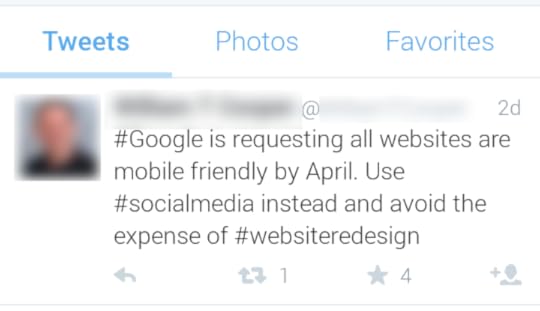 Just over a week ago, I saw this tweet from a self-proclaimed "social media expert":
Just over a week ago, I saw this tweet from a self-proclaimed "social media expert":
#Google is requesting all websites are mobile friendly by April. Use #socialmedia instead and avoid the expense of #websiteredesign
This is horrible advice. The worst ever. At first, I was embarrassed for this guy. He probably means well. Google is upgrading its search algorithm on April 21 and is using mobile friendliness as a factor. (Click here for more on Google’s Mobile-Friendly Algorithm Update.)
Then I started getting worried that nonprofits might actually take his advice. After all, his Twitter bio claims over 2 million "likes" on his Facebook page and over 18,000 executive connections on LinkedIn. These vanity statistics hopefully don't sway you, but they could make this sort of "advice" seem legit.
So, I turned to some social media experts to get their reaction to his advice.
9 Social Media Experts' Comments Nonprofits Going Mobile
Mary Cahalane

No expert, but I knew enough to make that a big consideration when I was choosing a theme and putting my own site together. And believe me, if I could do it, it's easily done!
Having worked with and at smaller organizations, Marc, I think it's likely the site they have was developed at a time when making changes was expensive and time-consuming. It usually required getting in touch with the company who put it together, paying them for the time to make the changes and waiting until they could get to it. (I remember disliking much about one website I had to work with - this was always the obstacle to making changes that would improve our fundraising).
So it may also be that the same organizations who haven't updated aren't doing so because they still think the process has to be expensive and time-consuming. And that they won't be able to manage the result themselves. But that's just no longer the case. So much has changed in the last 5 years!
 Jessica Daily
Jessica DailyAs someone who has worked through multiple web designs in the last years I can say without question there isn't a web designer out there who would design a website for you that isn't mobile friendly. Let me restate that... Not one you should consider paying a single penny to.
If your site is old enough that it isn't mobile friendly it's due for an overhaul anyway as it is, without question, horribly out of date and not simply because it's not mobile friendly but because it was likely designed many years ago. Has your nonprofit or business not changed at all in that time? Then like your website, your nonprofit is going the way of the dodo.
If you aren't showing that you are changing and growing why would you expect anyone to contribute? "Hey look! We're doing the same old thing with the same old results!" That's what an outdated website screams to potential funders.
I should also add that when I run ads on Facebook for my for-profits and nonprofits I have at least 50% mobile users, sometimes it's almost 100% mobile users. It's never less than 50%. If this is how people are accessing the web why would you ignore 50% or more of your audience? Would you deny 50% or more of your potential donations?
 Mordecai Holtz
Mordecai HoltzResponsive sites are the easiest way to amp up your sites for mobile. here's a post I just found http://www.sitepoint.com/10-ways-make-website-mobile-friendly/
Brands not reacting to this trend are basically acknowledging their lack of interest to iterate and modify their marketing content and brand to fit the technological realities and changing landscape of tomorrow. It would be a shame to see so many orgs/nfp's (other brands too) fail and become irrelevant over such a simple integration.
 Chris Tuttle
Chris TuttleIf someone's website does not meet the minimum standards of "mobile friendly" as of today, it's likely long-overdue for an overhaul anyhow. Even if this advice were practical (and unless one plans on being active and up-to-date on over 200 social networks around the world, it's simply not) I would still agree with Google's efforts to de-prioritize non-mobile friendly websites as an archiving method.
 Mark Hallman
Mark HallmanThat is terrible advice... anyone who spent their time building up their brand on MySpace instead of a website would be suffering the consequences now. My advice when I hear that kind of discussion is that we own our websites and we do not own our social media profiles, so behave accordingly.
Responsive design is standard practice now, definitely not a barrier to entrance for a mobile ready site.
 Nora Brathol
Nora BratholThe importance of having a mobile friendly website cannot be overstated. If you put a call out for donations on a social network like Twitter or Facebook, where the majority of users are on mobile devices, and then link to a site where it is difficult to actually donate, you've likely lost that donor.
 Mickey Gomez
Mickey GomezAt my last nonprofit (small and geographically based), we saw mobile use steadily climbing in the past year to the point where it is simply no longer an option to have a site that isn't mobile friendly.
And equating a web presence with social media is simply disingenuous. You own your web content, you manage it, you curate it and oversee it.
Social offers critical communication opportunities (engagement, information sharing, etc.) but you don't own the content. If the platform goes away, so does whatever your agency shared there.
That's why websites still exist - they are still the storage hub for information that you can choose to share via any number of platforms. The key is responsively managing content in a way that makes it accessible to users (mobile friendly, apps if/when feasible, easy online donation options).
...I realize most of this was already stated but I'm just stunned by the very idea of the advice given in the screen capture you shared and had to weigh in.
All of these responses were great. Possibly my favorite responses were from John Haydon and Jenna Sauber:
 John Haydon
John HaydonWhoa!
 Jenna Sauber
Jenna SauberDitto to John Haydon.
Bite the bullet and upgrade your nonprofit website
When people read my book on nonprofit social media, they are surprised to find chapters on your nonprofit's website, developing a blog, and growing your email list. Social media is a great tool, but it's not a substitute for your own website. Putting all your eggs in Facebook or Twitter means you could lose everything if they go out of business. Or if they simply change the rules.
Your nonprofit can keep your connections with supporters by having your own site and email list. With tools like WordPress, it's neither hard nor expensive. And like the experts show above, mobile friendly is now normal.
Bottom line: Take the time to make sure your site is mobile friendly - that it is able to be viewed on phones and tablets. These are only going to grow in use. And, as of April 21, Google will now be using mobile friendliness as a factor in mobile searches. So having a mobile friendly website will help donors find you, from whatever device they choose.
The post 9 experts weigh in on quite possibly the worst nonprofit mobile friendly advice ever appeared first on FundraisingCoach.com.








